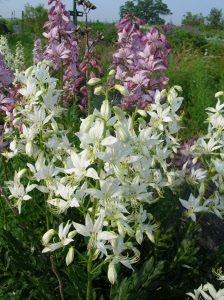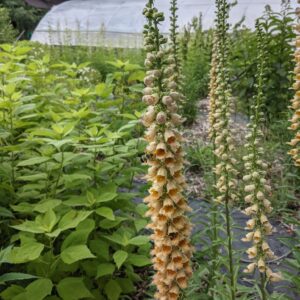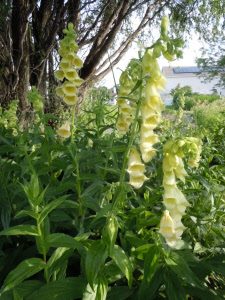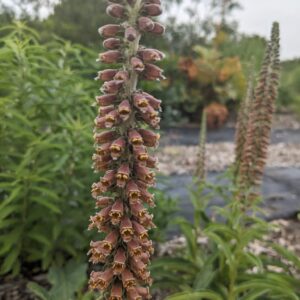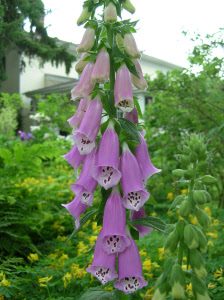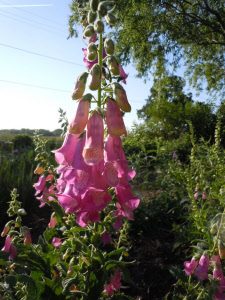Deer Resistant Plants
Showing 49–56 of 155 results
-
Dictamnus fraxinella syn. D. alba Gas plant, Burning bush Z 3-9
Magestic white or pink spikes of flowers in early summer, glossy, lemon-scented leaves
Magestic white or pink spikes of flowers in early summer, glossy, lemon scented leaves.
OUT OF STOCK
Size: 2-3' x 2' slow growing
Care: full sun to part shade in well-drained soil.
Native: Europe
Wildlife Value: Host for Giant Swallowtail caterpillars. Rabbit & deer resistant.
Awards: England’s Royal Horticultural Society Award of Merit.Dictamnus is from the mountain Dicte, located in Crete. Popular Elizabethan cottage garden plant since the late 1500’s. English herbalist John Gerard (1545-1612) called it “gallant.” Grown in the Eichstätt Garden, the garden of Johann Konrad von Gemmingen, prince bishop of Eichstätt in Bavaria, c. 1600. Grown by Jefferson at Monticello in the “center of the NW shrub circle,”1807. The roots used medicinally “resisting purification and poison.” Gardeners’ Dictionary, 1768. Once established very long-lived plant, “known to stand on the same place for fifty years still bearing healthy blooms.” The Garden Feb 19, 1876.
-
Digitalis ferruguina Rusty foxglove Z 4-7
Mottled rusty bells with brown speckled throats & hairy lips clothe the spikes in mid-summer. One of internationally known garden designer Piet Oudolf’s 100 “MUST HAVE” plants, Gardens Illustrated 94 (2013)
Mottled rusty bells with brown speckled throats & hairy lips clothe the spikes in mid-summer. One of internationally known garden designer Piet Oudolf’s 100 “MUST HAVE” plants, Gardens Illustrated 94 (2013)
Size: 4-5' x 18"
Care: sun to part shade in moist well-drained soil.
Native: Southern Europe and Balkans
Awards: England’s Royal Horticultural Society Award of Merit. Elisabeth Carey Miller Botanical Garden Great Plant Pick.The word ‘fox’ is said to be a corruption of ‘folk,’ meaning the ‘little folk’ or fairies. Foxgloves reputedly had the power to ward off witches and return children kidnapped by fairies Ferruginea means rust-colored from ferric describing metal containing iron. This species in garden cultivation since at least the 1590’s.
-
Digitalis grandiflora Yellow foxglove Z 4-8
Early to midsummer spires of moon yellow bells dress the flower spikes. Will rebloom if deadhead.
Early to midsummer spires of moon yellow bells dress the flower spikes. Will rebloom if deadheaded.
Size: 36" x 18"
Care: Sun to part sun, moist well-drained soil.
Native: Europe to Siberia and south to Turkey
Awards: Royal Horticultural Society Award of Merit. Elisabeth Carey Miller Botanical Garden Great Plant Pick.Liberty Hyde Bailey called foxgloves: “old-fashioned and dignified… The word ‘fox’ is often said to be a corruption of ‘folk,’ meaning the ‘little folk’ or fairies.” Foxgloves reputedly had the power to ward off witches and return children kidnapped by fairies. This species grown in the Eichstätt Garden, the garden of Johann Konrad von Gemmingen, prince bishop of Eichstätt in Bavaria, c. 1600. Common in Elizabethan cottage gardens.
-
Digitalis lutea Straw foxglove, Small yellow foxglove Z 3-9
Mid-summer, honey yellow, small bells encircle the flower spike
Mid-summer, honey yellow, small bells encircle the flower spike.
Size: 24" x 12"
Care: Sun to part shade in moist well-drained soil.
Native: Central Europe south to NW AfricaThe word ‘fox’ is often said to be a corruption of ‘folk,’ meaning the ‘little folk’ or fairies.” Foxgloves reputedly had the power to ward off witches and return children kidnapped by fairies. This species identified by Bavarian physician Leonhart Fuchs (1501-1566) in 1542. D. lutea mentioned in Gerard’s Herball in 1632.
-
Digitalis parviflora Chocolate foxglove Z 3-9
Spikes densely encircled with small, red-brown bells for weeks in summer, prune back after flowering to encourage reflowering.
OUT OF STOCK
Spikes densely encircled with small, red-brown bells for weeks in summer, prune back after flowering to encourage reflowering.
Size: 24- 60” x 12”
Care: sun to part shade in moist well-drained to well-drained soil
Native: Picos de Europa Mountains of Northern Spain
Wildlife Value: attracts bees and butterflies for its pollen and nectar, deer and rabbit resistant.
Awards: Royal Horticultural Society Award of Garden MeritGrown by Tradescant the Elder, 1634.
-
Digitalis purpurea Foxglove Z 4-8
pink, purple or white spires of spotted bells
OUT OF STOCK
Early summer pink, purple or white spires of spotted bells. Beautiful.
Size: 3-5' x 24"
Care: Part shade moist well-drained soil. Deer resistant
Native: Great Britain,west and central Europe east to Scandinavia, often escapes.Druids were fond of this Foxglove because it flowered at the same time as their midsummer sacrifice. First described by German physician and botanical author Leonhard Fuchs (1501-1566). Grown in Medieval gardens. The plant’s use as a heart stimulant was discovered in 1775 by English physician William Withering. The word ‘fox’ is said to be a corruption of ‘folk,’ meaning the ‘little folk’ or fairies,” having the power to ward off witches and return children kidnapped by fairies. Cultivated in America since 1700’s, with the first documented reference of American cultivation in 1748 by Peter Kalm, a student of Linneaus and a Swedish botanist who explored colonial America for plants. Pressed specimen in Emily Dickinson’s herbarium.
-
Digitalis thapsi Spanish foxglove Z 5-9
Spikes of purple, rose-spotted trumpets in early summer. True perennial
Spikes of purple, rose-spotted trumpets in early summer. True perennial.
Size: 18” x 12”
Care: sun to part shade in moist well-drained soil.
Native: Spain & PortugalGrown in the botanical gardens of Moscow by 1752. Philip Miller (1691-1771), chief gardener at London’s Chelsea Physic Garden, received seeds from Spain and grew this by 1760’s
-
Echinacea pallida Pale purple coneflower Z 4-8
Narrow, weeping pink rays in early to mid-summer surround its coppery-orange, hedgehog-like cone.
Narrow, weeping pink rays in early to mid-summer surround its coppery-orange, hedgehog-like cone.
Size: 2' x 14"
Care: Full sun in well-drained soil. Drought tolerant.
Native: much of continental US east of Colorado
Wildlife Value: deer resistant. Nectar feeds butterflies and hummingbirds. Birds eat seeds
Awards: Great Plants for Great PlainsEchinacea is Greek meaning hedgehog referring to the bristly conehead. Used to cure many ailments – arthritis, rheumatism, burns, colds, boils, fever, sore mouths, throats & gums, toothaches, snakebites, headaches, stings and distemper in horses – by several tribes – Cheyenne, Crow, Dakota and Sioux. 1st collected by English planthunter Thomas Nuttall (1786-1859) in Arkansas. Nuttall searched entire No. American continent, parts of Canada, from New England west to Oregon, the South, Midwest, the Plains, the S.E., California & Hawaii finding thousands of new plants.

